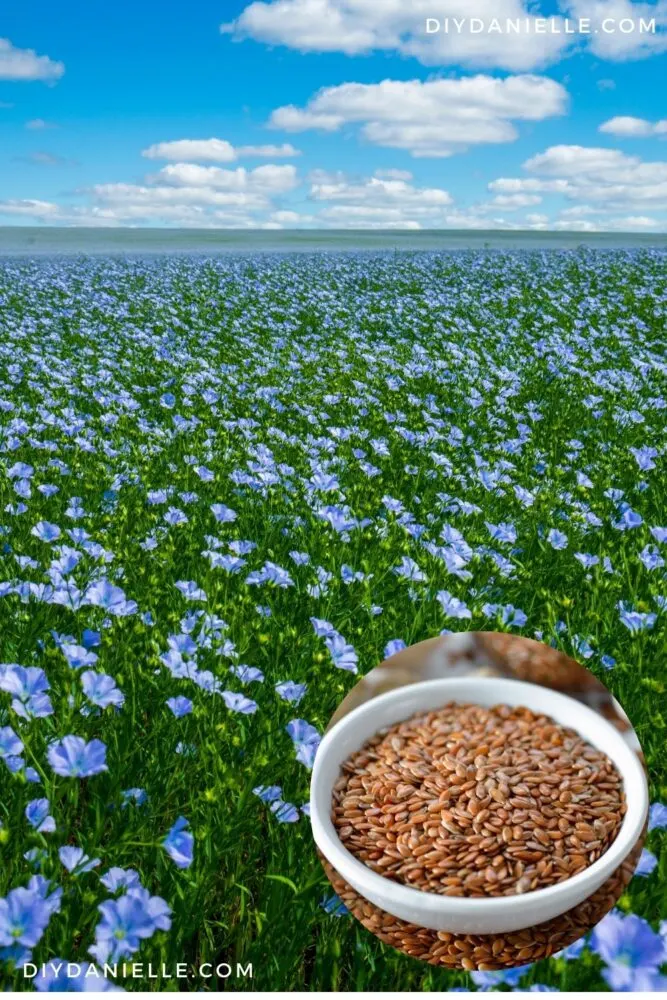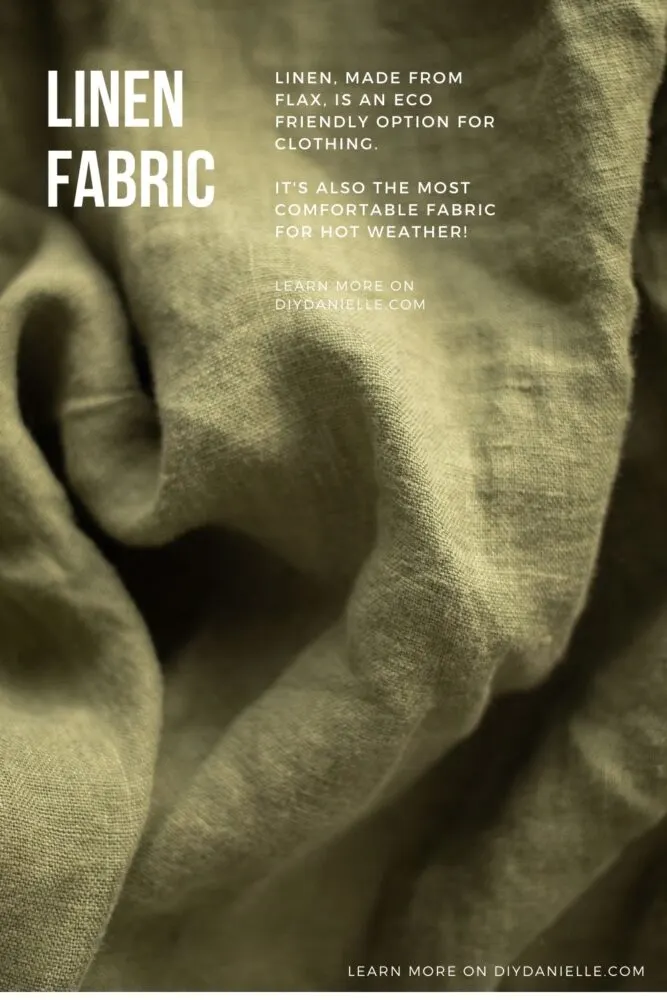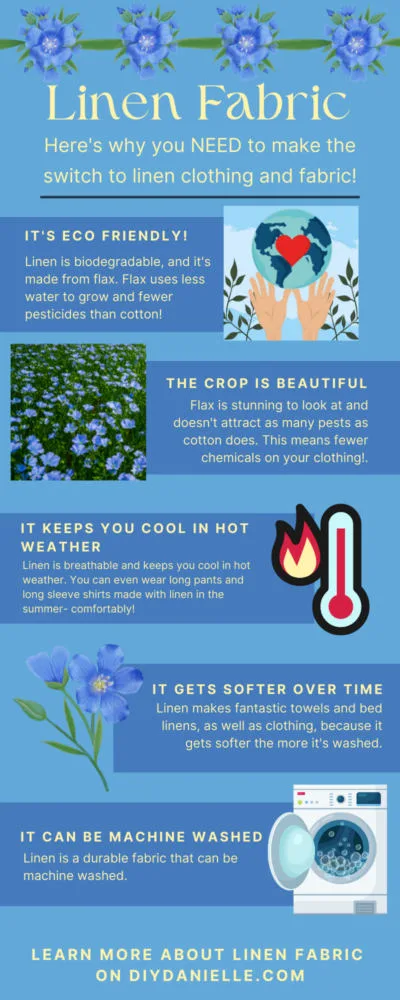What is linen fabric? This eco friendly fabric is the perfect choice for warm climates, and the flax it’s made from uses less water and pesticides to grow than cotton.
I’ve been interested in linen since our recent trip to Williamsburg, VA. During the tour, we visited the weaving area and the presenter was showing us the process for weaving linen into garments. He discussed some of the benefits of linen, such as being cooler to wear in the summer than cotton.

What I like best about linen though is that it’s made from flax, an eco friendly crop to grow because it uses less water and pesticides than cotton does. And isn’t it a LOVELY crop to grow?

While linen used to be quite common, now it’s less so due to consumer demand. Read more about linen and learn why we should be creating a greater demand for clothing and fabric made with flax!
This post may contain affiliate links which may earn me commissions should you click through them and take certain actions. As an affiliate for Amazon, Cricut, xTool, Home Depot, and other sites, I earn from qualifying purchases. Please DIY carefully. View my full legal disclosures here.
Please read the whole post so you don’t miss any important information!
What is Linen?
There are various different types of fabric that are used for everyday life: clothes, bedding, curtains, cloth napkins, and more. Whether you enjoy making your own clothing or household items, it is important to know what types of fabrics are out there, and which are best for what you are making.
One of the most versatile and widely used fabrics is linen, which comes from fine fibers of the flax plant. About 100 days after planting when flax stems are yellow and the seeds brown, the plants are harvested and processed to remove seeds and leaves. The stalks are then broken up to separate the usable fibers from the ones that can’t be used. The usable fibers are combed into strands and spun into yarn. Once dried, the yarn is dyed and treated, which makes it ready to create clothes, bedding and other products.
Linen is known as one of the oldest fabrics in the world. It is actually the type of fabric that Egyptians would use to mummify bodies of people who had passed. Linen fabric is very durable, strong and absorbent.
It is commonly used for bedding because it is very comfortable, soft and dries fast (perfect for people who sweat in their sleep or want to keep cool during the night).
One of the great benefits of linen fabric is that it is antibacterial! Germs and bacteria have a hard time surviving on linen because it is tightly woven. Additionally, linen is very easy to wash. They can be washed by hand and in the washing machine as well. Linen is also great for holding dye and you can find linen fabric in almost every color.
Since there is little elasticity in linen, it tends to wrinkle quite easily. One thing to watch out for is the linen shrinking, but other than that they are durable and will last you a good amount of years.
Types of Linen
Though there are many types of linen, there are four variations that are most commonly used: damask, plain-woven, loosely-woven, and sheeting linen.
Damask linen was first created in China around 300 B.C and is defined by its reversible embroidery-like pattern. It is made mostly for decorative purposes and is very durable and strong, thanks to its tightly-woven quality. The pattern of damask linen is created through two weaving techniques, which create a beautiful pattern that is perfect for curtains, tablecloths, table runners and more.
The linen fabric best used for cleaning purposes is plain-woven fabric because it is loosely woven, which makes it easy to absorb liquids and debris. Plain-woven fabric is soft enough to clean smudges off of glasses, which is why it is commonly referred to as glass toweling. It is not as durable as other types of linen, but it will last you a long time. Dishcloths, handkerchiefs, aprons are made with different styles of plain-woven linen.
Loosely-woven linens are also very absorbent, making it perfect for reusable diapers, dish towels, hand towels, tablecloths and sanitary napkins. A common variety of the loosely-woven linen is called Bird’s Eye because the geometric pattern resembles a bird’s eye. Huckaback linen is another variety that is made from a mix of linen and cotton to make things like lightweight bathroom linens.
Linen clothes is usually made out of sheeting linen because it is soft and untextured. It is heavier than other types of linen because it has a higher thread count, but that is what makes it great for suits, dresses, various types of clothing and bedding.
Best Linen Fabric for Clothing
Nowadays, linen isn’t used to make clothing as often as it was when it was first created because it was replaced with cotton. In places that have hot climates, linen is still used to create everyday clothing because of its moisture-wicking properties. Linen doesn’t retain moisture, and its natural while color reflects sun rays rather than absorb them.
Mostly any type of clothing can be made from linen. Shirts, dresses, pants, jackets, skirts, nightgowns and even lingerie and underwear can be made of linen. However, you can’t just use any type of linen for comfortable clothes. The best type of linen for clothes depends on what garment you are making, and for some that means a blend of linen with another fabric.
Rayon is often mixed with linen to create a garment that has a subtle sheen and drape nicely when worn. Since rayon is stretchy, a linen rayon blend can stretch more than 100% linen. Rayon also prevents the linen from wrinkling throughout the day. Summer clothes are typically made of linen rayon blend because they are very lightweight and breathable. Overall, linen rayon blend fabric is very comfortable and can be used for dresses, shirts, suits and more.
Linen cotton fabric blend is another common blend of fabrics used for clothing. It is very soft and breathable, and the blend of the two fabrics prevents the garment from wrinkling as much as the two fabrics alone. With the strength and durability of the linen and softness of the cotton, this blend is great for t-shirts.
Silk linen is another durable fabric that dries quickly and is wear-resistant. The silk adds softness to the blend and prevents the fabric from wrinkling. It also drapes very nicely when worn. This fabric blend is great for blouses, dresses and men’s shirts.
Though linen is an expensive fabric, it is a great fabric to use around the house because of its versatility and quality. It is very resilient and durable, so you know you’ll have it for years to come. Linen is also very easy to care for and will give you comfort all year round. And one of the best things about linen is that it is sustainable and eco-friendly! It requires less water than cotton, and the entire plant can be used for products such as linseed oil, food for livestock and wood-finishing products. As if there weren’t enough benefits already, linen is completely biodegradable!
Read more about other eco friendly fabrics here.
Linen for the 12th Anniversary
Coincidentally, this year is my husband and I’s 12th anniversary. Every year I panic about what to buy, then look up what the material of the year is. Did you know there’s a gift type for every anniversary?! This is crazy to me. Regardless, linen is the gift for the 12th anniversary.
I decided to buy him some linen handkerchiefs and linen bed sheets.And I put linen towels on my wish list because I LOVE how thin, yet soft they look. I feel like they’ll take up a lot less space in our linen closet than traditional towels. Maybe I’ll get some for Christmas!
Needless to say, I have sort of gone down the slippery slope where I want to replace all of my clothing with linen now… and preferably to SEW my own clothes with linen. It’d be fairly easy to do, particularly if I want to make pants and shorts. I love how linen clothing drapes casually when worn, and isn’t worn tight like a lot of knits.
But of course, I don’t have the infinite time that I think I do so I ended up picking up a couple of pairs of linen shorts and I’ll probably tackle a new piece of clothing occasionally.
Interested in learning more about different fabric types? Check out my other posts about fabric including: EcoFriendly Fabrics | What is Wool Fabric? | What is Silk Fabric? | What is Cotton Fabric? | What is Hemp Fabric? | What is PUL Fabric? | What is Polyester Fabric? | What is Tencel Fabric? | What is Minky Fabric?
Please share and pin this post! If you make this project, share it in our Stuff Mama Makes Facebook Group. We have regular giveaways for gift cards to craft stores. You can also tag me on Instagram @doityourselfdanielle; I love seeing everything you make!


